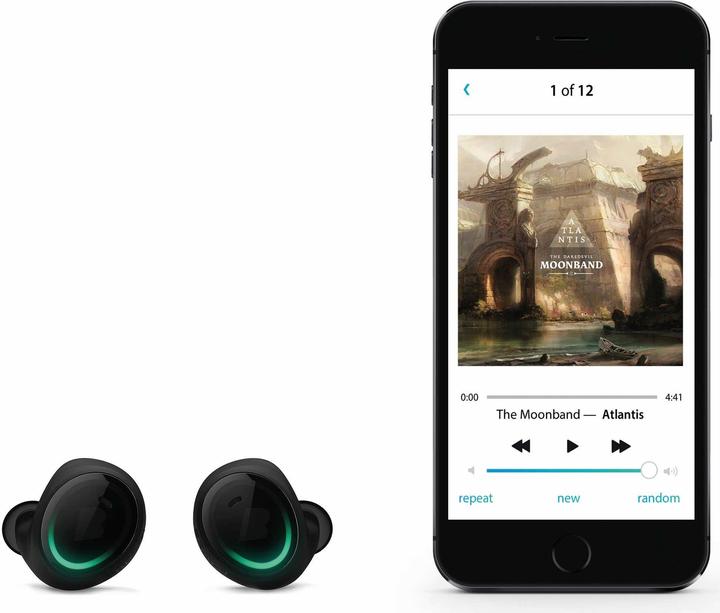
Bragi Dash - Headphones for the gym, not for everyday use
Cables are out. 3.5mm jack plugs are out. The headphones of the 21st century are wireless and are not just for listening to music. They are also fitness trackers and control your mobile. And since the future is here, I tested the pioneers of wireless headphones - the Bragi Dash.
Headphones are expensive again. They have regained prestige and are a topic of conversation among people who are not concerned with impedance and the eternal question of "in-ear or shell?". Because with the disappearance of cables connecting headphones to mobile phones and the disappearance of the 3.5 mm jack plug on the iPhone 7, revolution is the order of the day. Away with the old, towards the new.
One company that either predicted this trend or simply wanted to build something that didn't exist before is the German company Bragi. In their Kickstarter campaign in spring 2014, they received over three million dollars for the development of the first really good wireless headphones. The manufacturers actually only wanted 260,000. With the device called The Dash, headphones should finally become smart, i.e. not just have one function and offer the wearer advanced services.

- Pedometer
- Tachometer
- Movement frequency, i.e. things like the number of revolutions per minute on the bike
- Pulse metre
- Oxygen in the blood is measured
- Counts calories burned
- Bluetooth headset
- Bone conduction microphone
- Audio Transparency, which relays sounds from the environment into the ear, even when The Dash is activated
- Touch sensors on each headphone
The Dash also has 4GB of built-in memory that can be used for music. This should be particularly useful for swimmers, as they are unlikely to have their mobile on them when they are training. Oh yes, The Dash is waterproof up to one metre.
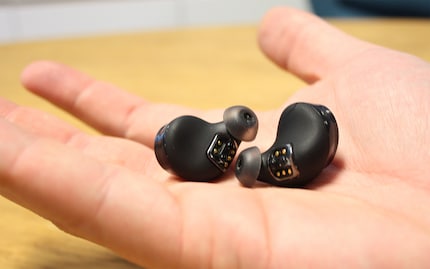
All this hardware is powered by a 100mAh lithium-ion battery per ear, providing around four hours of uninterrupted music and measurement enjoyment. Plusminus. Four hours isn't particularly long, but apart from marathon runners, hardly anyone is likely to train for four hours straight. Certainly not me.
An initial concern I had before receiving the device was quickly put to rest. I was worried that I would somehow lose the ear studs. But Bragi thought of that too and included a really sturdy charging stand that works as a kind of glasses case for headphones. After a month of daily use of the headphones and the case in my rucksack, I can say that anyone who is reasonably moderate with the Bragi Dash need not worry about the earbuds breaking or getting lost somewhere.
The software
Connecting the earbuds to the mobile is easy and is well illustrated by the instructions. The voice in my ear also explains how to proceed. The Dash uses Bluetooth Low Energy, a more energy-efficient Bluetooth mode
.
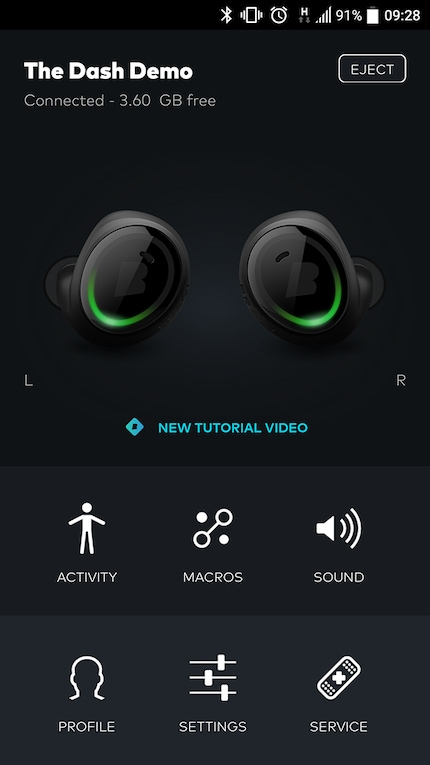
After a few attempts, because everything is new, it works wonderfully and with the words "I am now connected to your music library", Mrs Dash tells me that I can now listen to music.
The biodata is only measured via the Bragi app. This shows for the first time that Bragi either wants to give users little freedom or wants to encourage them to think outside the box. This is not because the app offers few options, but because the measurement of bike data is extremely limited. The app is only able to accurately measure cyclists, runners and swimmers. Also, not all data is recorded for all activities.
Biking:
- Pulse
- Duration of the training
- Rotations per minute
- Distance
- Speed
Swimming:
- Pulse
- Duration of the training
- Breaths
- Lengths swum
Running:
- Pulse
- Paces
- Distance
- Duration of the training
- Calories burnt
Calorie-counting cycling is not possible. Swimming with calories doesn't work. For exercisers who primarily want to lose weight by counting calories, the measurement data is useless in two thirds of cases. I myself would also like to see how many calories I burn when cycling. I can't. Disappointing.
It would be easier or, above all, more personalised if I could determine the measurement data myself, i.e. put together a customised measurement set. For example, a workout that measures calories, revolutions and breaths. Because if The Dash can already measure all this data, why don't users get the option to collect this measurement data according to their personal preferences?
Music only indoors
The critics on the internet are unanimous: music consumption with the Bragi Dash is frustrating. User Ronny1975 writes on our product page:
The BT connection is unfortunately not always good Music arrives choppy when the phone is in my trouser pocket. The manufacturer should work on this
Ronny1975 gives the Bragi Dash three out of five stars. This recognises the biggest weakness of the Bragi Dash. The Bluetooth connection is weak. Very weak, in fact. During the test, I was rarely able to listen to music outside for more than ten minutes without interruption. This is because the connection drops out and, as Ronny1975 correctly points out, choppy music sounds from the earbuds. Or not at all. These interruptions are several seconds long and in some cases about 45 seconds long. Sometimes Mrs Dash informs me that she has lost the connection with my mobile altogether.
For reference, I usually keep my mobile in my left trouser pocket. The Dash's music receiver is housed in the right earphone. The distance that the Bluetooth signal has to travel is around one metre. The fact that this doesn't work outdoors without problems is a killer argument for outdoor headphones.
But this is only the case when I'm outside. It turns out that The Dash is a device designed for athletes. Because if only the transmission and reception performance of the Bluetooth headphones is considered, then the case is clear: in the gym, the headphones work much better with very few dropouts. The prevailing theory among the editorial team is that there are enough walls and ceilings in the fitness centre from which the Bluetooth signal is reflected, making the Bluetooth field more stable. Another theory is that there are fewer energy fields in the gym that can influence the field.
The fact is that as long as there is a direct line of sight between the mobile and the headphones, the connection works even over several metres. The only strange thing is that swimming, cycling and running are not typical indoor activities.
The search for the exact measurement data
Bragi boasts that The Dash records a range of bio-data. The Dash's official website doesn't say exactly what this is for, but the implication is clear. Just like with all other trackers, Bragi promises greater success and better performance as well as better insight into your own performance and the associated training optimisation.
The sensor array measures the data reliably and without interruption, transmits it cleanly to the mobile and processes it cleanly in the app. The data is also transmitted cleanly to other apps such as Samsung's S Health or MyFitnessPal from Under Armour.
.
The Dash itself isn't compatible with as many apps as the competition on the market, but I was able to get my data into other apps that can't communicate directly with the Bragi app. Without further ado, I added another app in between and that was that.
At the beginning of the test phase, the test data was pretty inaccurate. However, the more workouts I completed with the earbuds in my ears, the more accurate the data became. They are still around 10 beats per minute below the measured value of a Polar watch used for comparison, but they are more or less where they should be. The problem is that I no longer trust the Dash. As much as the data adapts to my performance, I'm not entirely sure that it's correct.
Evaluation without a curve
I have to use other apps to analyse the data over time. This is because the Bragi app itself does not offer any obvious statistical analyses. So no curve and no timeline. All the Bragi app offers is one entry per workout.
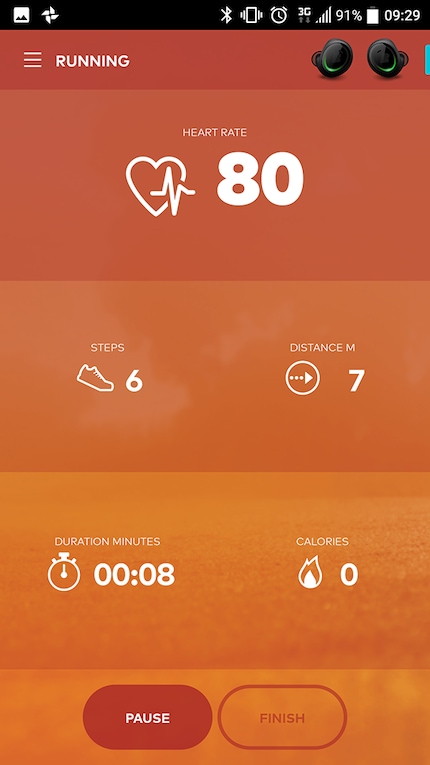
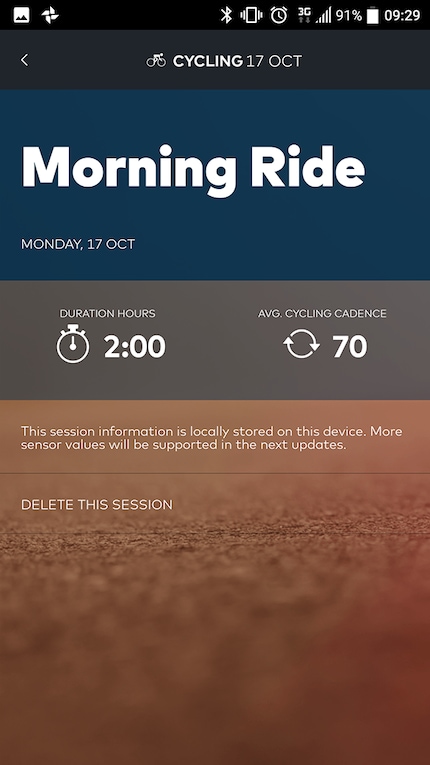
It is still possible to get these curves. But not in the Bragi app. Google Fit offers these curves. The combination of the Bragi app, Google Fit and MyFitnessPal provides a fairly complete picture of my diet, weight and training over time. The fact that the Bragi app can't do this is weak.
On the other hand, according to LinkedIn, Bragi has 120 employees from all over the world. This is a relatively small team compared to its big competitor Jawbone, which employs 323 people according to LinkedIn. However, the output of the two companies is comparable. If such personnel bottlenecks exist, then the strategy of relying on an open API from another manufacturer such as Google is totally legitimate for economic reasons. However, this should be clearly communicated for reasons of transparency, just like the limited intercompatibility with other apps. Instead, Bragi advertises a complete suite that is in fact far from complete.
A good start
The Bragi Dash are solidly made and promise a lot. The elegant devices sit well in the ear and the case looks sturdy. If Bragi continues to focus on such stable workmanship, strong batteries and operation via touch surfaces, the company could establish itself as one of the best manufacturers of wireless headphones.
The Bragi Dash are made for indoor athletes, as the Bluetooth field requires reflective surfaces in order to function without major interruptions. The Dash are therefore perfect for training in the studio. Outdoor athletes have to reckon with interruptions if they don't wear the phone on their upper arm. However, I cannot recommend the Dash as everyday headphones. The reception with the transmitter in your trouser pocket is too weak for that.
For analysis purposes, I recommend using another tool that can analyse things like curves. However, thanks to the open standards of Google Fit and the Android platform in general, this is not a problem and you can look for the analysis options that suit you best.
Wireless headphones with additional functions have a future and Bragi presents a solid prototype with the Dash. The Dash have some teething problems, but if Bragi continues to develop the model, we should get an extremely good device.
The final verdict: Bragi's The Dash is almost great. But only almost. <p
Journalist. Author. Hacker. A storyteller searching for boundaries, secrets and taboos – putting the world to paper. Not because I can but because I can’t not.

